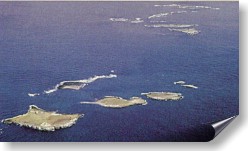
|
||
 |
The Farne Islands
The Farne Islands were used as a retreat by Anglo-Saxon monks from the 7th century. The first known inhabitant was St. Aidan who went to live there and meditate in 640 AD. St. Cuthbert, the next inhabitant followed Aidan in 676 AD and he lived alone on the Island until 684AD. Two years later he returned to Inner Farne where he died in March 687 AD. His body is kept at Durham Cathedral which we also hope to visit. The Farne Islands are now a nature reserve providing a sanctuary for a large colony of grey seals and many thousands of sea birds including eider ducks, shags, puffins, terns and guillemots. Between 15 and 28 of the Farne Islands are visible, depending on the tide. To get there, we'll have to paddle through powerful tidal currents, past blowholes, and through standing waves. For more information, see Visit Northumbria: The Farne Islands
|

Longstone Lighthouse on the island of Longstone, the most seaward island in the Farne Islands. It was occupied after it was built in 1826, but it is automatic now.
|

